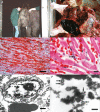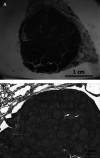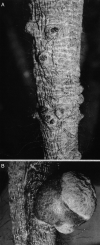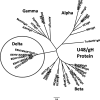Review of Elephant Endotheliotropic Herpesviruses and Acute Hemorrhagic Disease
- PMID: 26912715
- PMCID: PMC4765743
- DOI: 10.1093/ilar/ilv041
Review of Elephant Endotheliotropic Herpesviruses and Acute Hemorrhagic Disease
Abstract
More than 100 young captive and wild Asian elephants are known to have died from a rapid-onset, acute hemorrhagic disease caused primarily by multiple distinct strains of two closely related chimeric variants of a novel herpesvirus species designated elephant endotheliotropic herpesvirus (EEHV1A and EEHV1B). These and two other species of Probosciviruses (EEHV4 and EEHV5) are evidently ancient and likely nearly ubiquitous asymptomatic infections of adult Asian elephants worldwide that are occasionally shed in trunk wash secretions. Although only a handful of similar cases have been observed in African elephants, they also have proved to harbor their own multiple and distinct species of Probosciviruses-EEHV2, EEHV3, EEHV6, and EEHV7-found in lung and skin nodules or saliva. For reasons that are not yet understood, approximately 20% of Asian elephant calves appear to be susceptible to the disease when primary infections are not controlled by normal innate cellular and humoral immune responses. Sensitive specific polymerase chain reaction (PCR) DNA blood tests have been developed, routine monitoring has been established, the complete large DNA genomes of each of the four Asian EEHV species have now been sequenced, and PCR gene subtyping has provided unambiguous evidence that this is a sporadic rather than epidemic disease that it is not being spread among zoos or other elephant housing facilities. Nevertheless, researchers have not yet been able to propagate EEHV in cell culture, determine whether or not human antiherpesvirus drugs are effective inhibitors, or develop serology assays that can distinguish between antibodies against the multiple different EEHV species.
Keywords: Elephas maximus; Loxodonta Africana; Probosciviruses; calves; elephant endotheliotropic herpesvirus (EEHV); elephant hemorrhagic disease; lung and skin nodules.
© The Author 2016. Published by Oxford University Press on behalf of the Institute for Laboratory Animal Research. All rights reserved. For permissions, please email: journals.permissions@oup.com.
Figures







References
-
- Atkins L, Zong J-C, Tan J, Mejia A, Heaggans SY, Nofs SA, Stanton JJ, Flanagan JP, Howard L, Latimer E, Stevens MR, Hoffman DS, Hayward GS, Ling PD. 2013. EEHV-5, a newly recognized elephant herpesvirus associated with clinical and subclinical infections in captive Asian elephants (Elephas maximus). J Zoo Wildl Med 44:136–143. - PMC - PubMed
-
- Bouchard B, Xaymountry B, Thongtip N, Lertwatcharasarakul P, Wajjwalku W. 2014. First reported case of elephant endotheliotropic herpes virus infection in Laos. J Zoo Wildl Med 45:704–707. - PubMed
-
- Ehlers B, Dural G, Marschall M, Schregel V, Goltz M, Hentschke J. 2006. Endotheliotropic elephant herpesvirus, the first betaherpesvirus with a thymidine kinase gene. J Gen Virol 87:2781–2789. - PubMed
-
- Fickel J, Lieckfeldt D, Richman LK, Streich WJ, Hildebrandt TB, Pitra C. 2003. Comparison of glycoprotein B (gB) variants of the elephant endotheliotropic herpesvirus (EEHV) isolated from Asian elephants (Elephas maximus). Vet Microb 91:11–21. - PubMed
-
- Fuery A, Tion J, Ling PD, Long SY, Heaggans SY, Hayward GS. 2015. EEHV infection in surviving USA Asian elephant calves. J Zoo Wildl Med In press.
Publication types
MeSH terms
Grants and funding
LinkOut - more resources
Full Text Sources
Other Literature Sources

